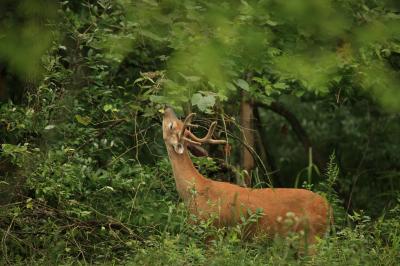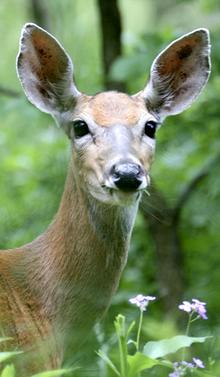"A growing number of Westchester and New York State biologists believe that heavy deer browsing exacerbates the effects of other human-created impacts on the environment such as habitat loss, invasive species proliferation, soil degradation and erosion, acid rain, and pesticides – which together jeopardize the survival of many wildflowers, hinder regeneration of trees and other plants, and potentially threaten important ecological services (e.g. quality of drinking water supplies) provided by healthy forests."
William S. Greenawalt, Esq., Chairman Citizens’ Task Force on White-tailed Deer and Forest Regeneration


The picture on the top shows a healthy forest floor, with a diversity of plants on the ground, seedlings and small trees. The second picture shows an over-browsed forest floor, carpeted with the invasive weed garlic mustard and no seedlings or small trees visible. You can see this for yourself if you go for a walk in the "woods" - check how far you can see(because there are no small trees or shrubs blocking your view!), how much barberry you encounter, and look for small trees - you won't find many! At the Lasdon Arboretum they've set up an area with a fence where you can look on one side and see what the deer have done, while directly on the other side you see the expected biodiversity.
The deer are nibbling away at the natural diversity of the eastern forest. Studies show an alarming lack of tree seedlings per acre, and once-dense thickets of rhododendron and mountain laurel are sparse and open. In some areas of Pennsylvania, where scientists have carefully documented the forest undergrowth, there is simply no viable regeneration of trees and shrubs going on at all. The white-tailed deer population devours shrubs, saplings, wildflowers and other underbrush - each deer chewing up thousands of pounds of plants and acorns a year.
This phenomenon is referred to as "deer over-browsing". For many young plants, deer bite off the whole stem of the plant, including its flower, so no seed is formed, thereby preventing reproduction. Slow-growing trees spend many years in the forest shrub layer before they can grow beyond the reach of deer. But the biggest threat is not the loss of individual species, but a gradual overall reduction in plant diversity resulting in a “simplified” forest that is less able to bounce back from disturbance, whether natural or manmade.
“In a diverse system, there is always another species that can take up the slack,” said Larry Rhoads, Supervisor of the Forest Pest Suppression Section, PA Dept. of Conservation and Natural Resources. “If one species is affected by an insect or a disease, there’s another that can move in, shifting the balance. When the forest consists of little more than red maple and hay-scented fern, there’s no backup, no ability to shift and take up the slack when one species is affected, and thus no resilience.”
Nor are impacts limited to plants. Some understory birds, most of which are neotropical migrants that journey between Eastern forests and the tropics each year, have been declining 3-5 percent a year. Studies suggest that is largely because of increased nest predation on those species. Deer may be making those species more vulnerable to predation.
“If you’re trying to nest in the lower six feet of the forest and there is no lower six feet, you’re sticking your nest out in a very obvious place and it’s being hammered relatively soon in your nesting phase,” said William McShea, a research scientist with the Smithsonian Institution’s Conservation and Research Center.
Also, when some species are over-browsed, other plants less desirable to deer take their place. Those new species may be able to outcompete native species that were decimated by the deer population. So even if the deer population is reduced, and maintained at lower densities over time, diversity may still not be reestablished.


